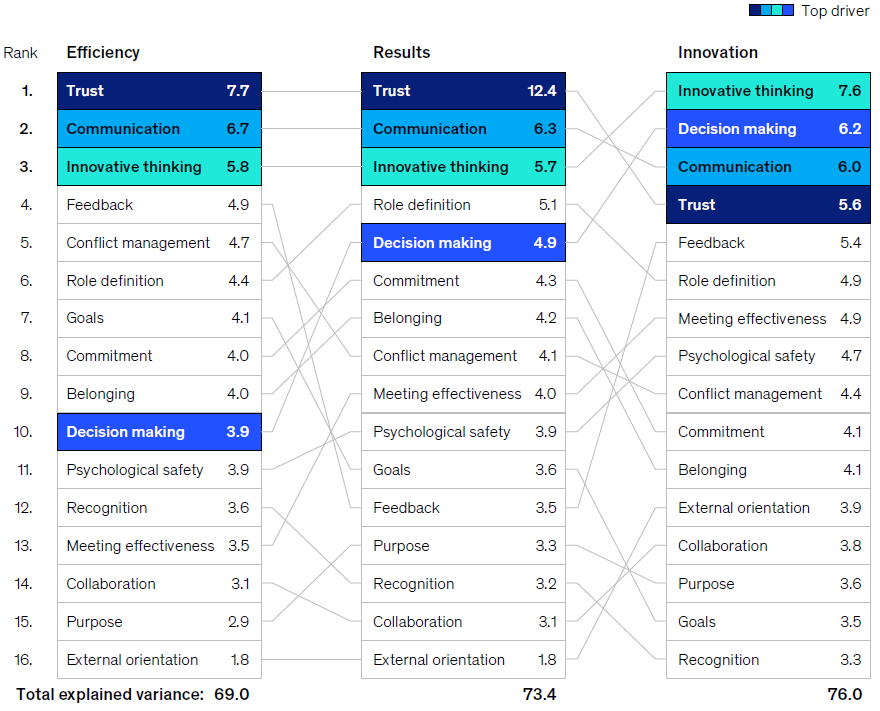Chief Human Resources Officers (CHROs) face the challenge of creating a corporate culture that not only strengthens employee retention but also promotes productivity and reduces absenteeism.
In this article, I explore some key issues facing CHROs this year, the crucial role of corporate culture and leadership, as well as their impact on employee engagement and health.
The goal is to use scientific research and selected practical examples to demonstrate how companies can create a positive working environment that increases both employee satisfaction and performance.
Key topics facing CHROs this year
The following key topics are currently being discussed in talks with CHROs and SVPs HR:
Strategy & Sustainability
HR plays a central role in implementing sustainable corporate strategies by promoting and monitoring social sustainability. This includes compliance with standards such as CSRD´s ESRS S1, which takes social criteria into account in sustainability reporting. Companies are increasingly measuring and managing social sustainability to strengthen employee retention through meaningful work and sustainable corporate values.
The shortage of skilled workers requires an innovative talent strategy to meet future needs. Reskilling and upskilling are crucial to preparing employees for digital and sustainable transformation. Artificial intelligence (AI) is playing an increasingly important role in HR strategies, particularly in the automation of HR processes. Furthermore, the flexibilization of working models, such as hybrid work or project work, is becoming increasingly relevant for future-proof workforce planning.
HR departments must prepare for new labor and ESG regulations, including CSRD, the EU Supply Chain Law/Act and the AI Regulation. Strong HR risk management and ethical corporate governance are essential for operating successfully in a changing regulatory environment. In addition, data-based HR decisions and predictive analytics are becoming increasingly important for strategic workforce planning to develop long-term and accurate workforce strategies.
Culture, leadership and triple transformation
The further development of leadership culture, for example through servant leadership or adaptive leadership, is crucial for the successful implementation of modern HR strategies. There is a growing focus on promoting employee mental health as an integral part of HR strategy. Diversity, equality and inclusion (DEI) are increasingly understood as an important business case, while employee engagement and meaningful work must be further strengthened.
The introduction of AI into HR processes such as recruiting and learning & development requires clear governance to increase efficiency and provide personalized experiences. By using digital HR technologies, companies can automate their processes and improve the employee experience. In this context, data protection and the ethical use of AI are of central importance to build trust while enabling data-driven decisions in HR.
Role of corporate culture and leadership
I would like to briefly highlight this topic because, in my opinion, it forms the basis for a successful HR strategy. Corporate culture and leadership can be quite challenging in an environment of rising absenteeism, declining performance and diminishing engagement. However, it is precisely in such difficult times that it is all the more important to work specifically on corporate culture and leadership skills in order to reverse these negative trends. Here are some thoughts:
Leadership, sense of purpose & open communication
In times of high absenteeism and low performance, the role of managers becomes crucial. They should be able to identify the causes of these developments and take appropriate action. Lack of support, little recognition, or inadequate communication often play a role. By actively listening, responding empathetically and promoting transparent communication, managers can positively influence employee well-being.
An often-underestimated factor in declining engagement is the lack of purpose and meaning in work. When employees feel that their work has little meaning or is not aligned with their personal values, not only performancce but also engagement declines. Companies can create a meaningful environment by establishing a comprehensive mission statement for the positive impact of work on society and the environment. Employees who identify with the company’s values tend to be less affected by burnout and more engaged.
Another important aspect is the active employee involvement. When employees feel that their opinions and suggestions are heard and incorporated into decision–making, it promotes engagement and reduces frustration. Open dialogue, in which problems are openly addressed and solutions are worked out together, helps reduce absenteeism and strengthen employee retention.
Prevention, work organization & continuing education
Promoting mental health should be an important component of corporate culture. In times of high stress, it is crucial that companies take preventative measures. A lack of engagement and high absenteeism can be signs of burnout or overload. Targeted stress management programs, flexible work models, or even coaching and mentoring programs can help promote employee health and motivation.
High absenteeism and low performance can also be caused by inefficient or inflexible work organizations. Introducing flexible work models, such as hybrid work, can help better distribute the workload and improve the work-life balance. The ability to switch between the office and home office or to organize working hours according to one’s needs can not only reduce sickness absence but also increase engagement and performance.
If the engagement index drops and performance stagnates, this can often also indicate a lack of development opportunities and a lack of challenge. Reskilling and upskilling programs can help employees to develop further in their roles, acquire new skills and grow professionally. This not only boosts performance, but also strengthens a sense of belonging and long-term commitment to the company.
Impact on employee retention, well-being, engagement and performance
Many of these measures to improve corporate culture, leadership and well-being require financial investments and could be perceived as an additional performance burden in the short term. However, there are also ways to view these investments as long-term strategies that have a positive impact on performance and pay off financially.
Investing in employees as a long-term return
Measures such as continuing education or more flexible working models may cost money initially. But if viewed as an investment in human capital that makes the company stronger and more resilient in the long term, the costs can quickly be offset by the positive effects. Studies show that companies that invest in employee well-being achieve higher productivity, lower turnover rates and fewer sick days in the long term. These factors directly contribute to increased performance and reduce recruitment and sick leave costs in the long term.
Investments in engaged employees and meaningful work pay off through higher employee retention. High employee turnover is associated with high recruitment costs. By creating a positive work environment in which employees feel supported and valued, a company can increase employee retention while simultaneously reducing the costs of recruiting and training new employees. Employees who identify with the company are also more productive and motivated.
Prevention and flexibility as performance boosters
High levels of sickness absence and declining performance can be expensive in the long term, both in terms of direct costs, such as absences and health insurance, and in terms of lost potential, such as reduced innovation and demotivated teams. If companies take preventive measures to promote well-being, they can prevent small problems from becoming larger, cost-intensive ones in the long term. For example, stress management or mental health can be seen as an investment to avoid expensive burnouts or lengthy sick leave, which would otherwise significantly impact performance and cost structure.
Although flexible and hybrid work models may initially appear to be a cost factor, numerous companies are proving that hybrid work and similar models lead to higher employee satisfaction, which directly impacts willingness to perform. The ability to better balance work and private life can increase satisfaction and productivity while also boosting employee retention without incurring additional office space or other infrastructure costs.
Culture and leadership as differentiators and competitive advantages
Companies with a strong corporate culture that values openness, trust, and recognition can not only attract talent, but also promote innovation and collaboration that boost performance. A positive work environment leads to employees not only being more motivated at work, but also more creative and willing to take on more responsibility. Companies that foster this culture have a clear competitive advantage, as they are able to attract and retain top talent and foster innovation, which is directly reflected in corporate performance.
Companies that value their employees and emphasize the importance of meaning and purpose at work create an environment that strengthens employee retention and increases willingness to perform. Especially in an increasingly competitive labor market, many employees are not only looking for high compensation, but also for meaning in their work. This can increase engagement and motivation, which has a direct positive impact on performance.
In the short term, such measures may incur costs, but in the long term, they can serve as a differentiator from competitors and strengthen the company’s brand.
Examples from research and practice
With modern HR analytics tools, such as Alteryx and Visier, companies can evaluate the impact of measures such as flexibility and leadership culture on employee performance and make informed decisions. These data-based approaches make it possible to make the right investments and target measures to increase productivity. Companies can also determine which measures have the greatest positive impact on engagement and performance, and make their investments more efficient.
Research by McKinsey found that a few “health factors” – innovation, decision-making, communication, and trust – together explain between 69% and 76% of the differences between low- and high-performing teams when it comes to three key outcomes:
- efficiency (the team is productive and meets its deadlines);
- results (the team achieves its goals and delights stakeholders); and
- innovation (the team innovates in ways that are critical to long-term company value).
Interesting company examples of these statements can be found here, among otheres: the Salesforce Equality Report, the Microsoft Work Trend Index, the SAP Global Impact Report, the Unilever Sustainable Living Plan, the Gallup Employee Engagement Survey, McKinsey’s publications on “The Future of Work”, the BMW Health & Fitness Initiative, the Novartis People & Culture Insights, and the Nestlé Creating Shared Value and Sustainability Report.
Conclusion
The topics around employee engagement and sickness absence are central to the successful implementation of any HR strategy. CHROs not only have to respond to flexible working models and digital transformation, but also create a corporate culture that promotes trust, decision–making, communication, and innovation. Leaders play a key role in this by not only acting as role models but also by actively contributing to a positive working environment. Companies that combine these elements can not only increase employee engagement in the long term, but also reduce sickness absence. It is the combination of innovative HR initiatives and strong, empathetic leadership that makes the difference and forms the basis for a healthy, productive workplace.
While measures to improve corporate culture and employee well-being involve short-term costs, it is crucial to view them as long-term investments. The positive effects achieved through high employee retention, increased productivity, reduced sickness absence, and higher engagement can more than offset initial expenses and sustainably increase company performance. The trick is to find a balance and clearly communicate the long-term benefits of such investments so that they are not perceived as a burden, but as necessary steps for future success.



Leave A Comment